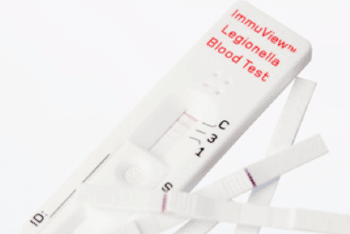Lateral Flow Test Applied to Legionellosis Diagnostics
By LabMedica International staff writers
Posted on 08 Jan 2014
Early diagnosis of Legionnaires’ disease is especially important to establish the correct choice of antibiotic treatment for the patient.Posted on 08 Jan 2014
The diagnosis of Legionnaires' disease has traditionally been based on culture of the bacterium Legionella pneumophila, which is quite time-consuming and has a relative low sensitivity, and on antibody detection in serum samples.

Image: The ImmuView Legionella Lateral Flow Blood Test (Photo courtesy of Statens Serum Institut).
Microbiologists at the Statens Serum Institut (SSI; Copenhagen, Denmark) investigated 79 serum samples from 50 Danish patients from different parts of the country identified with Legionnaires' disease. The 50 patients consisted of 32 males, age range 33 to 85 years, and 18 females, age range 43 to 80 years. Some patients had more than one sample included, in order to follow the development of antibodies and the sensitivity of the assays.
All cases were laboratory-confirmed by different combinations of the following tests: urinary antigen test, culture, serology, and polymerase chain reaction (PCR). The samples were further investigated in four different assays: an in-house enzyme-linked immunosorbent assay (ELISA) test for L. pneumophila serogroup 1 and 3 immunoglobulins IgM/IgG antibodies, a lateral flow test called ImmuView Legionella Blood test for serogroups 1 and 3 IgM (SSI Diagnostica; Hillerød, Denmark), and two different commercial ELISAs.
Of the 79 samples, 18 samples from 16 patients were negative or borderline in all four tests. Most other samples were positive in some or all of the used tests and as expected IgM was found to be positive earlier than IgG. Overall, there is a good correlation between the results from the different tests, especially between the in-house ELISA, the lateral flow test ImmuView, and the ELISA from Virion/Serion (Würzburg, Germany). The ELISA from Euroimmun (Lübeck, Germany) did not seem to be as sensitive as the other three tests.
The authors noted that for diagnosis of legionellosis and especially Legionnaires' disease it must be remembered that antibodies to Legionella can persist for a long time after an infection and that mild and even asymptomatic infection can elicit an antibody response. Therefore, positive results should be judged in combination with the symptoms of the patient and other microbiological test results and confirmed with at least one other diagnostic method. They concluded that the lateral flow test is an easy and fast method and that the sensitivity is on the same level as ELISA based assays. Furthermore, the ImmuView seems to be more sensitive in the very early phase of disease, compared to the other commercial tests. The study was published in the January 2014 issue of the Journal of Microbiological Methods.
Related Links:
Statens Serum Institut
SSI Diagnostica
Virion/Serion








 (3) (1).png)





